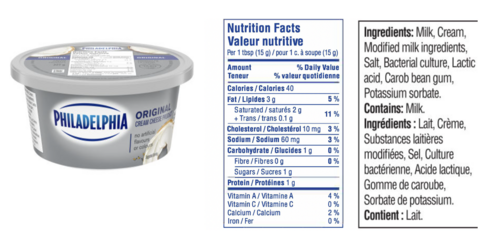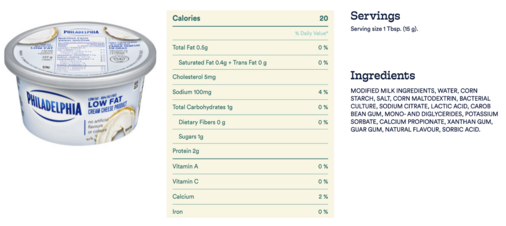Course:FNH200/Assignments/2023/Philadelphia Original Cream Cheese vs Philadelphia Low Fat Cream Cheese
Brief Introduction of Philadelphia Cream Cheese
Philadelphia cream cheese is a soft, creamy, and mildly tangy fresh cheese that originated in the United States. It is made from a mixture of cream and milk, which undergoes a process of pasteurization. The cheese has a smooth and spreadable texture, making it ideal for various culinary applications. Philadelphia cream cheese is commonly used as a spread on bagels, as an ingredient in cheesecakes, dips, and frostings, or as a base for savory dishes.
Low-fat cream cheese is a variation of traditional cream cheese that has a reduced fat content. It is made using a similar process as regular cream cheese, but with a lower percentage of milk fat. This results in a lighter and less creamy texture compared to full-fat cream cheese. Low-fat cream cheese is often chosen by individuals seeking a lower-calorie or lower-fat alternative while still enjoying the creamy and tangy taste of traditional cream cheese. It can be used in similar ways as regular cream cheese, such as spreading on bagels, adding to recipes, or as a lighter topping for desserts.
In this project, our team aims to conduct an analysis to understand and compare the variances between the original and low-fat versions of Philadelphia cream cheese.
Pictures


Ingredient lists
| Philadelphia Original Cream Cheese | Philadelphia Low Fat Cream Cheese |
|---|---|
| Milk, Cream, Modified Milk Ingredients, Salt, Bacterial Culture, Lactic Acid, Carob Bean gum, Potassium Sorbate | Modified Milk Ingredients, Water, Corn Starch, Salt, Corn Maltodextrin, Bacterial Culture, Sodium Citrate,
Lactic Acid, Carob Bean Gum, Mono and Diglycerides, Potassium Sorbate, Calcium Propionate, Xanthan Gum, Guar Gum, Natural Flavour, Sorbic Acid |
Additives are substances that are added to food products during processing or preparation to perform specific functions. These functions can include preserving the quality and freshness of the food, enhancing its taste and appearance, improving texture and consistency, and extending its shelf life. Looking at the original cream cheese we can see that they have additives:
Lactic acid
- Lactic acid plays an important role in cream cheese.
- Lactose is fermented and converts to lactic acid which lowers the pH creating curds.
- These curds are soli and it traps fat and liquid in cheese giving it a smooth and creamy texture.
- It also contributes to the tangy and slightly sour taste of cream cheese. The longer the fermentation process, the more lactic acid is produced, resulting in a more pronounced tangy flavor.
Bacterial culture
- Manufacturers select specific strains of lactic acid bacteria, such as Lactococcus lactis and Streptococcus thermophilus. These bacteria are known for their ability to ferment lactose into lactic acid, which is crucial for the reasons mentioned above.
Carob bean gum
- is derived from the seeds of the carob tree (Ceratonia siliqua) and is primarily used:
- thickening: as it has the ability to trap water
- stabilizing agent: prevent the separation of water and fat in cream cheese
- fat reduction: replace some of the fat content in cream cheese without significantly compromising its texture
- emulsion stability: keeps the water and fat phases dispersed evenly throughout the product
Potassium sorbate
- extend the shelf life of food by inhibiting the growth of molds, yeasts, and certain bacteria, helping to prevent spoilage and maintain the quality of the product.[2]
| Philadelphia Original Cream Cheese | Philadelphia Low Fat Cream Cheese | |
|---|---|---|
| Fat Substitutes | N/A | Mono and Diglycerides |
| Suger Substitutes | N/A | N/A |
| Additives | Bacterial Culture, Lactic Acid, Carob bean gum, Potassium sorbate | Sodium Citrate, Lactic Acid, Carob Bean Gum, Potassium Sorbate, Calcium Propionate,
Xanthan Gum, Guar Gum, Natural Flavour, Sorbic Acid, Corn Maltodextrin, Corn Starch |
As mono and diglycerides substitutes fats in original cream cheese, more additives have been used to maintains its texture and taste in addtions to lactic acid, carob bean gum, and potassium sorbate. Additional additives found in low-fat cream cheese are:
Mono and Diglycerides[3]
- help oil and water to blend (emulsifier); they can be used to improve the texture and consistency of foods.
- Since they have a similar molecular structure to triglycerides, but with one or two fatty acids removed, it allows them to function as a source of fat without adding the same amount of calories or fat content.
Sodium Citrate[4]
- allows cheese to melt without becoming greasy.
Calcium Propionate
- acts as a preservative to help extend shelf life by interfering with the growth and reproduction of molds and other microorganisms.
Xanthan Gum[5]
- used as an emulsifier in cheese to prevent oil layering and improve the stability of cheese, preventing protein accumulation.
Guar Gum[6]
- prevents syneresis or weeping by water phase management, therefore, it improves the texture and body of the cream cheese.
Natural Flavour[7]
- derived from plants or animals and used to add flavor
Sorbic Acid[8]
- a preservative used to inhibit mold and yeast growth
Corn Maltodextrin
- a carbohydrate based fat substitute and helps maintain the similar smooth texture.
Corn Starch
- used as thickening suspending and gelling agents
| Original (15g) | Low Fat (15g) | |
|---|---|---|
| Main Ingredients | milk, cream, modified milk ingredients, salt | modified milk ingredients, water |
| substitutes and additives | lactic acid, bacterial culture, carob bean gum, potassium sorbate | Sodium Citrate, Lactic Acid, Carob Bean Gum, Potassium Sorbate, Calcium Propionate,
Xanthan Gum, Guar Gum, Natural Flavour, Sorbic Acid, Corn Maltodextrin, Corn Starch |
| total fat | 3g (5%) | 0.5g (0%) |
| cholestrol | 10 mg | 5 mg |
| sodium | 60 mg (3%) | 100 mg (4%) |
| protein | 1 g | 2 g |
| total carbohydrates | 1 g | 1 g |
The original cream cheese contains 11% of saturated and trans fat per 15g serving. In comparison, the low-fat cheese has a lower fat content with 2.7% saturated and trans fat in same amounts. The low-fat version has significantly reduced the percentage of saturated fat compared to the original variety. Also, cholesterol has reduced from 10 mg to 5 mg for the same serving size while protein increased 1g to 2g. This reduced the total calories in the low fat version to 20 calories per 15g compared to the 40 calories per 15g in the original version.
Furthermore, the original cream cheese contains bacterial culture, lactic acid, carob bean gum, and potassium sorbate as additives. The low-fat cream cheese also includes these additives, along with additional additives like sodium citrate, mono and diglycerides, calcium propionate, xanthan gum, guar gum, natural flavor, and sorbic acid to maintain the flavor similar even though fat is reduced.Therefore, the low-fat version has a higher number of ingredients compared to the original version.
Labels
| original | low fat | |
|---|---|---|
| bilingual labeling | both in English and French, following the mandatory regulations | |
| common name of the food | Cream Cheese | Low Fat Cream Cheese |
| Country of Origin | United States | |
| Date Marking and Storage Instruction | Date Marking: best before the date printed on the top of the packaging
Storage: Refrigerated | |
| Identify and Principal Place of Business | Kraft Foods Group - Toronto, Ontario | |
| List of Ingredients | Milk, Cream, Modified Milk Ingredients, Salt, Bacterial Culture, Lactic Acid, Carob Bean gum, Potassium Sorbate | Modified Milk Ingredients, Water, Corn Starch, Salt, Corn Maltodextrin, Bacterial Culture, Sodium Citrate,
Lactic Acid, Carob Bean Gum, Mono and Diglycerides, Potassium Sorbate, Calcium Propionate, Xanthan Gum, Guar Gum, Natural Flavour, Sorbic Acid |
| Nutritional Facts | Calories: 40 / Fat: 3g / Cholestrol: 10 mg / Sodium: 60 mg / Carbohydrates: 1 g (Sugar 1g) / Protein 1 g / Vitamin A: 4% / Vitamin C: 0% / Calcium: 2% / Iron: 0% | Calories: 20 / Fat: 0.5g / Cholestrol: 5 mg / Sodium: 100 mg / Carbohydrates: 1 g (Sugar 1 g) / Protein 2 g / Vitamin A: 0 % / Vitamin C: 0% / Calcium: 2% / Iron: 0 % |
| Irradiated Foods | N/A | N/A |
| Allergens | Milk | Milk |
| Sweeteners | N/A | N/A |
| Claims and Statements | No artificial flavours or colours | low fat - 95% fat-free
No artificial flavours or colours |
Food labeling requirements in Canada are regulated by the Canadian Food Inspection Agency (CFIA) and fall under the Food and Drugs Act (FDA) and Food and Drug Regulations (FDR).For Philadelphia Cream Cheese, it would is expected to comply with the labeling requirements outlined by the CFIA. These requirements include accurate and clear information regarding the product's identity, ingredients, nutritional information, allergen declarations, and any other mandatory labeling elements specified by Canadian regulations.
Based on our investigation both version of Philadelphia cream cheese meet the labelling requirements outlined by the CFIA and any nutrient claims or health claims adhere to the criteria for Canada. Also, all food additives found in the original and low fat cream cheese are permitted food additives in Canada.
References
- ↑ "PHILADELPHIA Original Cream Cheese". Kraft Canada. Retrieved July 18, 2023.
- ↑ Brighenti, M. (2020). "Behavior of stabilizers in acidified solutions and their effect on the textural, rheological, and sensory properties of cream cheese". Journal of Dairy Science. 103 – via American Dairy Science Association.
- ↑ Vandergriendt, Carly (Oct 11, 2017). "What Are Monoglycerides and Are They Safe to Consume?". healthline. Retrieved July 18, 2023.
- ↑ "10. List of Permitted pH Adjusting Agents, Acid-Reacting Materials and Water Correcting Agents (Lists of Permitted Food Additives)". Government of Canada. April 14, 2021. Retrieved July 18, 2023.
- ↑ Katzbauer, Babara (June 19, 1997). "Properties and applications of xanthan gum". Polymer Degradation and Stability. 59: 81–84 – via ScienceDirect.
- ↑ Mudgil, Deepak (October 4, 2011). "Guar gum: processing, properties and food applications—A Review". Journal of Food Science and Technology. 51 – via National Library of Medicine.
- ↑ Lehman, Shereen (October 19, 2022). "Why Natural Flavors Are Listed as a Food Additive". Verywellfit. Retrieved July 18, 2023.
- ↑ Özdemir, Ayse (January 23, 2020). "Determination of Sorbic Acid in Cheese Samples by Rapid HPLC-DAD Method". International Journal of Analytical Chemistry – via National Library of Medicine.
| This Food Science resource was created by Course:FNH200. |
